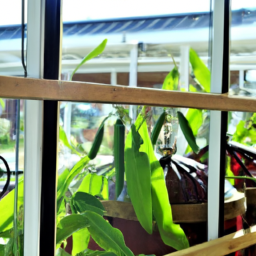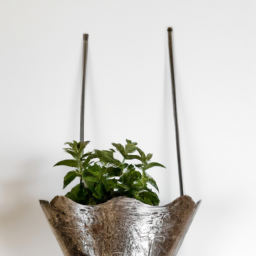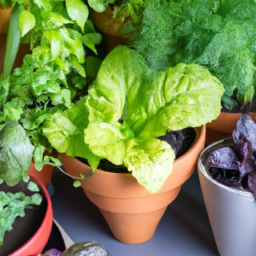
Are you tired of relying on store-bought produce that lacks the fresh, vibrant flavors you crave? If so, it’s time to consider creating your own edible container gardens. With these miniature gardens, you can enjoy the taste of homegrown herbs, vegetables, and fruits, even if you don’t have a backyard or outdoor space. In this blog post, we will explore the wonderful world of edible container gardens and how they can bring fresh flavors indoors, allowing you to savor the deliciousness of homegrown produce all year round. So, let’s dive in and discover the joys of cultivating your own mini garden right in the comfort of your own home.
Benefits of Edible Container Gardens: Fresh Flavors at Your Fingertips
Welcome to the world of edible container gardens, where you can bring fresh flavors right into your home! Whether you have limited outdoor space, a desire for year-round gardening, or simply want to add a touch of greenery to your living space, edible container gardens offer a multitude of benefits. In this guide, we will explore the advantages of growing your own edible garden indoors and provide you with a step-by-step guide to get started.
Enhanced Flavor and Nutrition
One of the most significant benefits of growing an edible container garden indoors is the enhanced flavor and nutrition it provides. When you grow your own herbs, vegetables, and fruits, you have complete control over their growing conditions. This means you can ensure they receive optimal sunlight, water, and nutrients, resulting in produce that is bursting with flavor and packed with nutrients.
Furthermore, by harvesting your crops at the peak of ripeness, you can enjoy fruits and vegetables that are at their nutritional peak. Store-bought produce often travels long distances and may lose some of its nutritional value during transportation and storage. With an indoor edible garden, you can harvest your crops and consume them immediately, maximizing their nutritional benefits.
Additionally, growing your own food allows you to avoid the use of harmful pesticides and chemicals. You can choose organic growing methods and ensure that your produce is free from harmful residues, making it healthier and safer for you and your family.
Year-Round Gardening
Another advantage of edible container gardens is the ability to enjoy gardening year-round, regardless of the season or climate. With indoor gardening, you are not limited by external factors such as frost, extreme temperatures, or limited sunlight. You can create a controlled environment that mimics the ideal growing conditions for your chosen plants.
By utilizing techniques such as grow lights and temperature control, you can provide your plants with the necessary light and warmth, even during the winter months. This means you can have fresh herbs, vegetables, and even fruits all year long, regardless of the weather outside.
Moreover, year-round gardening allows you to experiment with a wider variety of plants. You can grow exotic herbs or vegetables that may not be readily available in your local grocery stores. Imagine having a constant supply of fresh basil, cherry tomatoes, or even strawberries, right at your fingertips!
Space Optimization and Aesthetics
One of the main reasons people turn to edible container gardens is the ability to optimize space and add a touch of greenery to their living spaces. Whether you live in a small apartment, have limited outdoor space, or simply want to bring nature indoors, container gardening offers a flexible solution.
With container gardens, you can make use of vertical space by utilizing hanging baskets or wall-mounted planters. This allows you to grow a larger variety of plants without taking up valuable floor space. You can transform your balcony, kitchen windowsill, or even a sunny corner of your living room into a thriving garden.
Furthermore, edible container gardens add aesthetic value to your home. The lush green foliage, colorful fruits, and aromatic herbs create a visually appealing and inviting atmosphere. You can choose containers that complement your interior decor and create a harmonious blend of nature and design.
Now that you understand the numerous benefits of edible container gardens, it’s time to get started on your own indoor garden. Follow our step-by-step guide below to embark on a flavorful and rewarding gardening journey.
Disclaimer: The information provided in this guide is for educational purposes only and should not be considered as professional gardening advice. Please consult with a horticulturist or gardening expert for personalized guidance.
Step 1: Choose the Right Containers
The first step in creating an edible container garden is selecting suitable containers for your plants. Consider the size and growth habits of your chosen plants to determine the appropriate container size. Ensure that each container has drainage holes to prevent waterlogging, which can lead to root rot.
For herbs and smaller vegetables, such as lettuce or radishes, individual pots or shallow containers work well. For larger plants or those with sprawling growth, such as tomatoes or peppers, opt for deeper and wider containers to accommodate their root systems.
When it comes to materials, there is a wide range of options available. Clay pots are popular for their breathability, but they can dry out quickly. Plastic containers are lightweight and retain moisture better, but they may not offer as much breathability. Choose containers that suit your gardening style and the needs of your plants.
Step 2: Select the Right Growing Medium
The next crucial step is choosing the right growing medium for your plants. Avoid using garden soil, as it is often too heavy and may contain pests or diseases. Instead, opt for a high-quality potting mix specifically formulated for containers.
Potting mixes are typically lighter, well-draining, and enriched with nutrients. They provide an ideal environment for root development and plant growth. Look for mixes that contain organic matter, such as compost or peat moss, to improve moisture retention and nutrient availability.
Fill each container with the potting mix, leaving a small gap between the soil surface and the rim of the container to allow for watering.
Step 3: Choose the Right Plants
Now comes the fun part – selecting the plants for your edible container garden! Consider the available space, light conditions, and your personal preferences when choosing plants.
Herbs like basil, thyme, rosemary, and mint are popular choices for indoor gardens. They are compact, aromatic, and can be used in various culinary creations. Leafy greens such as lettuce, spinach, and kale are also great options, as they grow relatively quickly and provide a continuous harvest.
If you have enough space, you can even try growing small vegetables like cherry tomatoes, peppers, or dwarf varieties of beans and cucumbers. Just ensure that the chosen plants are suitable for indoor growing conditions and can thrive in containers.
Step 4: Provide Adequate Light
Light is a crucial factor in the success of your indoor edible garden. Most edible plants require at least 6-8 hours of direct or indirect sunlight daily. Place your containers near a south-facing window or provide supplemental light using grow lights.
Grow lights are available in various types, including fluorescent, LED, and high-intensity discharge (HID) lights. Each type has its advantages and considerations, so choose the one that suits your budget and the needs of your plants.
Remember to adjust the height and duration of light exposure based on the specific light requirements of your plants. Monitor their growth and make necessary adjustments to ensure they receive adequate light for healthy development.
Step 5: Water and Nutrient Management
Proper watering and nutrient management are essential for the health and productivity of your edible container garden. The frequency and amount of water needed depend on various factors, including the plant species, container size, and environmental conditions.
Check the moisture level of the soil regularly by inserting your finger into the soil up to the first knuckle. If it feels dry, it’s time to water. Ensure that water reaches the root zone by watering until it drains out of the bottom of the container.
However, be cautious not to overwater, as it can lead to root rot and other issues. Allow the soil to dry slightly between waterings, but never let it completely dry out.
In terms of nutrients, container-grown plants may require more frequent fertilization compared to those grown in the ground. Choose a balanced, water-soluble fertilizer specifically formulated for edible plants. Follow the manufacturer’s instructions for application rates and frequency.
Step 6: Pest and Disease Management
Just like outdoor gardens, indoor edible container gardens may encounter pests and diseases. Regularly inspect your plants for any signs of pests, such as aphids, mites, or whiteflies. If detected, take immediate action to prevent the infestation from spreading.
There are various organic pest control methods you can employ, such as introducing beneficial insects, using insecticidal soaps or neem oil, or physically removing the pests. Avoid using chemical pesticides, as they may contaminate your produce and harm beneficial insects.
Additionally, practicing good hygiene and providing proper airflow can help prevent the development of diseases. Remove any dead or decaying plant material promptly and ensure adequate ventilation around your plants.
Step 7: Harvest and Enjoy!
Finally, the reward for all your efforts – harvesting your homegrown produce! Harvest your crops at the peak of ripeness for the best flavor and nutritional value. Use sharp, clean scissors or pruning shears to avoid damaging the plants.
Enjoy your freshly harvested herbs, vegetables, and fruits in your favorite recipes. The joy of cooking and eating dishes made with ingredients you grew yourself is truly unparalleled.
Remember, gardening is a continuous learning process. Don’t be afraid to experiment, make mistakes, and adapt your approach based on the needs of your
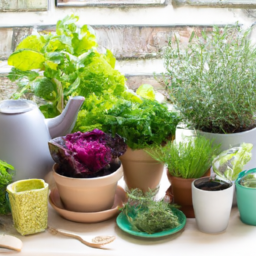
How to Start an Edible Container Garden: A Step-by-Step Guide
Gardening is a wonderful way to connect with nature and enjoy the fresh flavors of homegrown produce. However, not everyone has access to a large outdoor space for a traditional garden. That’s where edible container gardens come in. With a few simple steps, you can start your own indoor garden and enjoy fresh flavors all year round. In this guide, we will walk you through the process of starting an edible container garden.
Choosing the Right Containers
The first step in starting an edible container garden is selecting the right containers. When choosing containers, consider the size and material. Opt for containers that are at least 12 inches deep to allow enough room for root growth. Additionally, make sure the containers have drainage holes to prevent waterlogging.
When it comes to materials, there are various options available. Clay pots are popular for their natural look and breathability, but they can dry out quickly. Plastic containers, on the other hand, retain moisture better but may not be as aesthetically pleasing. Ultimately, the choice depends on your personal preference and the specific needs of your plants.
It’s also important to consider the size of the containers. Larger containers can hold more soil, which means more nutrients for your plants. However, smaller containers may be more suitable for herbs or smaller vegetables.
Choosing the Right Location
Once you have your containers ready, the next step is to choose the right location for your indoor garden. Most edible plants require at least six hours of direct sunlight each day, so it’s crucial to find a spot that receives adequate sunlight.
An ideal location for an indoor garden is near a south-facing window. This will provide your plants with the maximum amount of sunlight. If you don’t have access to a sunny window, you can also use grow lights to supplement the light requirements of your plants.
In addition to sunlight, consider the temperature and humidity levels in the chosen location. Most edible plants thrive in temperatures between 60-75°F (15-24°C) and humidity levels of 40-60%. Avoid placing your containers near drafts or heating vents, as these can affect the temperature and humidity levels.
Choosing the Right Plants
Now that you have your containers and location sorted, it’s time to choose the right plants for your edible container garden. Consider the space available, as well as your personal preferences and culinary needs.
Herbs like basil, rosemary, and mint are excellent choices for indoor gardens. They are relatively easy to grow and can be used to add flavor to various dishes. Leafy greens such as lettuce, spinach, and kale are also great options, as they grow quickly and can be harvested multiple times.
If you have more space available, you can also grow small vegetables like cherry tomatoes, peppers, or even dwarf varieties of beans and cucumbers. Just make sure to check the specific requirements of each plant and ensure they are suitable for container gardening.
Planting and Caring for Your Edible Container Garden
Now that you have everything ready, it’s time to plant and care for your edible container garden. Start by filling your containers with a well-draining potting mix. Avoid using garden soil, as it can be too heavy and may contain pests or diseases.
Once your containers are filled with potting mix, plant your chosen seeds or seedlings according to the instructions on the packet. Make sure to provide enough space between plants to allow for proper growth.
Water your plants regularly, keeping the soil moist but not soggy. Container gardens tend to dry out quicker than traditional gardens, so it’s important to monitor the moisture levels regularly. You can also consider using a water-soluble fertilizer to provide your plants with essential nutrients.
As your plants grow, make sure to provide support if needed. Some plants, like tomatoes or peppers, may require stakes or cages to keep them upright. Regularly check for pests or diseases and take appropriate measures to control them.
Harvest your plants when they are ready. Most herbs can be harvested by snipping off the leaves as needed. Leafy greens can be harvested by cutting the outer leaves, allowing the inner leaves to continue growing. Vegetables should be harvested when they reach their mature size and color.
With these simple steps, you can start your own edible container garden and enjoy the fresh flavors of homegrown produce right in your own home. Get creative with your plant choices and experiment with different flavors. Happy gardening!
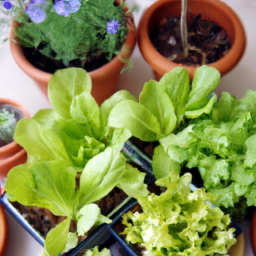
Best Plants for Edible Container Gardens: Enhancing Your Indoor Culinary Experience
Introduction
Welcome to the world of edible container gardens! If you are looking to enhance your indoor culinary experience, growing your own fresh flavors indoors is a fantastic way to do it. Not only does it provide you with a convenient and readily available source of herbs and vegetables, but it also adds a touch of greenery and freshness to your living space. In this guide, we will explore the best plants for edible container gardens, allowing you to create a thriving mini garden right in your own home.
Choosing the Right Plants
When it comes to selecting plants for your edible container garden, there are a few key factors to consider. Firstly, think about the available space and light conditions in your home. Different plants have varying light requirements, so it’s important to choose ones that will thrive in your specific environment. Additionally, consider your own culinary preferences. Do you love cooking with fresh herbs? Or are you more interested in growing your own salad greens? Tailor your plant selection to suit your tastes.
Now, let’s dive into some of the best plants for edible container gardens:
1. Herbs
Herbs are a must-have for any indoor garden. They add incredible flavors to your dishes and are incredibly easy to grow in containers. Here are a few favorites:
Basil: This aromatic herb is a staple in many cuisines. It thrives in bright, sunny spots and requires regular watering.
Mint: Mint is a refreshing herb that can be used in both sweet and savory dishes. It prefers partial shade and moist soil.
Parsley: A versatile herb that adds a fresh taste to a variety of dishes. It grows well in containers and requires moderate sunlight.
These are just a few examples, but there are many more herbs to explore based on your personal taste preferences.
2. Salad Greens
Imagine being able to pick fresh salad greens right from your indoor garden whenever you want. Here are a few options to consider:
Leaf Lettuce: Varieties like butterhead lettuce or loose-leaf lettuce are perfect for container gardens. They require moderate sunlight and regular watering.
Spinach: Spinach is packed with nutrients and can be grown in containers with ease. It prefers cooler temperatures and partial shade.
Arugula: Arugula adds a peppery kick to salads and sandwiches. It grows quickly and thrives in cooler temperatures.
These greens not only provide a fresh and healthy addition to your meals but also serve as an aesthetically pleasing display in your indoor garden.
3. Compact Vegetables
If you have a bit more space in your containers, consider growing some compact vegetables. Here are a few options that are well-suited for indoor gardens:
Cherry Tomatoes: Compact tomato varieties, such as cherry tomatoes, can be grown in pots. They require ample sunlight and regular watering.
Mini Bell Peppers: These small-sized bell peppers are perfect for container gardens. They need plenty of sunlight and well-draining soil.
Radishes: Radishes are fast-growing and can be harvested within a few weeks. They prefer cooler temperatures and regular watering.
These vegetables not only provide you with fresh produce but also add a pop of color to your indoor garden.
Conclusion
Creating an edible container garden is a rewarding and enjoyable experience. By selecting the right plants for your indoor space, you can enhance your culinary journey and enjoy the flavors of freshly picked herbs, salad greens, and compact vegetables. Remember to consider the light conditions in your home and your personal taste preferences when choosing plants. With a little care and attention, your indoor garden will flourish, providing you with a continuous supply of fresh flavors throughout the year. Happy gardening and happy cooking!
Key Takeaways of this article
Are you tired of relying on store-bought herbs and vegetables that lack flavor? Why not bring the freshness of the outdoors inside your home with an edible container garden? Not only will it add a touch of greenery to your living space, but it will also provide you with a constant supply of fresh and flavorful ingredients for your meals.
Creating an edible container garden is easier than you might think. All you need is a sunny spot near a window, some pots or containers, and a variety of herbs and vegetables that you love. Whether you have a spacious kitchen or a small apartment, there are options for every space. From basil and mint to cherry tomatoes and lettuce, the possibilities are endless. Plus, you don’t need to worry about the weather or pests ruining your harvest. With an indoor garden, you have full control over the growing conditions, ensuring optimal growth and flavor. So, why not try your hand at creating an edible container garden and enjoy the fresh flavors of homegrown produce all year round?
Let me leave you with some FAQs:
Q1: What is an edible container garden?
A1: An edible container garden is a small-scale garden that allows you to grow a variety of edible plants in containers, such as pots, planters, or even hanging baskets. It’s a convenient way to cultivate fresh flavors indoors, especially if you have limited space or lack a traditional garden.
Q2: What can I grow in an edible container garden?
A2: You can grow a wide range of edible plants in your container garden, including herbs like basil, mint, and parsley, as well as vegetables like tomatoes, peppers, lettuce, and cucumbers. You can also experiment with growing fruits like strawberries or dwarf varieties of citrus trees.
Q3: How do I start an edible container garden?
A3: Starting an edible container garden is relatively simple. First, choose a suitable location that receives adequate sunlight, whether it’s a sunny windowsill, balcony, or patio. Next, select containers with good drainage and fill them with nutrient-rich potting soil. Plant your chosen seeds or seedlings, water them regularly, and provide proper care, including fertilizing and pruning as needed.
Q4: What are the benefits of growing an edible container garden indoors?
A4: Growing an edible container garden indoors offers several benefits. Firstly, it allows you to have fresh, homegrown produce readily available, even if you don’t have access to an outdoor garden. Secondly, it provides a convenient way to incorporate fresh flavors into your cooking without having to rely solely on store-bought ingredients. Additionally, indoor gardening can be a therapeutic and rewarding hobby, promoting relaxation and reducing stress.
Q5: Are there any challenges to consider when growing an edible container garden indoors?
A5: While growing an edible container garden indoors is generally easier than maintaining a traditional outdoor garden, there are a few challenges to keep in mind. Indoor plants may require additional artificial lighting, especially during the winter months when natural sunlight is limited. Additionally, proper watering and humidity control are crucial to prevent over- or under-watering your plants. Pests can also be a concern, so regular monitoring and pest management may be necessary.

Lisa Chen is a seasoned indoor gardening expert and the author of several bestselling books on the topic. With a background in horticulture and urban farming, Lisa is dedicated to helping urban dwellers embrace the joys of cultivating green spaces indoors. Her detailed guides and hands-on tips empower readers to transform their living spaces into thriving plant sanctuaries.

